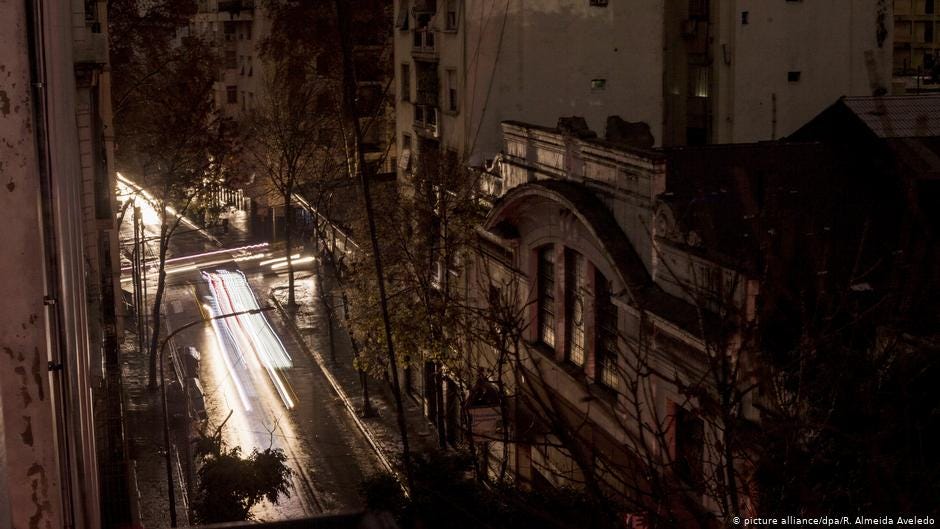Argentina’s Big Blackout
Dear listener, we interrupt our regular programming with breaking news (OK, fine, broken news) from Argentina, where on Sunday, June 17 a rolling blackout left 50 million people (including millions in Paraguay and Uruguay) without electricity. This spectacular system failure merits a closer look. In the meantime, I’m making some decisions about what I want for this newsletter, so stay tuned for that. I did already decide to start opening up the newsletter to whomever is interested, though I’ll keep it in beta until I really find my stride. So if you have friends or colleagues who might qualify as such as a person, please forward this or any letter! The link to subscribe is in the bottom. Thanks!
Qué pasó?

Argentina’s President Macri called it “unprecedented”, while the country’s energy secretary called it “very extraordinary”. Early press concomitantly speculated about its causes and its implications. An author for Wired.com figured that as “Argentina experienced heavy rains over the weekend”, it might well be extreme weather that caused it – just as it has done and will increasingly do so in the US (so American reader beware). Al Jazeera quotes an “independent energy expert” who blamed it on known errors in the design of the Argentinian grid and failures to address it. Finally, Vox speculated about the possible political career of this blackout – the energy system has been a controversial part of Macri’s austere politics of economic revitalisation (see below). The latest provisional verdict holds that a temporary transmission line that replaced a high voltage line that was under repair buckled under the weight of two hydroelectric plants.
Perhaps, thus, it is less a sign of the state of Argentina’s electricity grid and more of a freak accident. The aforementioned independent energy expert, however, does not think so: the company in question should have known this could happen.
While we wait for the ultimate verdict, you may be interested in learning a little more about this grid, the politics that shaped it, and what lies in store for its future. If so, you’re in luck, because that’s what I wrote about!

Once upon a time, there was the crisis
Let’s start by saying that not all is well in Argentinian energy land. Argentinians regularly cope with blackouts or scheduled interruptions. Some of these blackouts are major: during a (yes, extreme!) heatwave in the win… er, summer of 2013-2014, over 200,000 people in Buenos Aires were left without electricity for up to ten days (Procupez 2013).
In good part, the fragility of the grid follows more or less directly from the financial and economic crisis in 2001. In the decade preceding that crisis, Argentina had embarked on an extensive programme of privatisation, selling off state-owned enterprises to mostly foreign investors (Electricité de France was among the buyers.) In order to provide a safer financial environment for foreign investors, Argentina pegged its peso to the dollar, shielding investors from value fluctuations of their assets. This strategy actually worked out relatively well for the electricity sector, which saw new infrastructural investment, increased service reliability and overall financial viability of the new energy companies.
However, the overall package of privatizations of which this relative success was a part, turned out to have produced an untenable situation. Not in the least because of the massive layoffs from the former state-owned enterprises, the economy could not sustain the state’s budget, and it became increasingly difficult to uphold the peg between the peso and the dollar. When at last, in 2001, the government was forced to give up this monetary policy, the peso nose-dived, losing 70% of its value. The ensuing economic crisis plunged 58% of its population below the poverty line and sent shockwaves through a western world that was still riding the high wave of its free-market triumph after the Soviets ended history with the (economically equally traumatic) dissolution of their Republic (see Munck 2005 for a comparison between both ‘collapses’, as cited in Haselip & Potter 2010: 1169).
The consequences for the energy sector were – in broad strokes – as follows. As mentioned, the energy sector itself was doing relatively ok until that point but the crisis threw in a big ol’ monkey wrench. Many foreign investors left (including EDF). Further, in order to prevent people from falling into absolute destitution, the government instituted a freeze on energy prices. While reasonable and perhaps even imperative as social policy, over time it created systemic tensions. With prices increasingly out of sync with costs, it became more difficult for companies to get a return on maintenance or upgrade investments. Also, with prices low, there are few incentives for customers to reign in consumption and thus reduce demand (although this is a specious argument if no technology to reduce such demand is available). Notable detail: President Macri rolled back the freeze, in what has proven an unpopular move. (Another, major source of energy demand is the construction sector. Anxious to save their money into something solid, rather than something as fluffy and ethereal as currency, people preferred investing in “bricks” [see D’Avellla 2014]. This too was an effect of the crisis.)
When will the future be renewable?

Subsequent governments have tried to preserve this hobbled energy market, while re-writing some of its rules of engagement. They also attempted to create opportunities for investment, as with time, the grid became more and more fragile. Over the last decade, renewables have become an explicit part of that policy palette. While the country continues to bank on its own (depleting) reserves of natural gas, renewable sources of energy are a matter of existential need in light of perennial energy shortages. Local renewable sources are also obvious candidates to electrify remote rural areas, expensive as grid extension is comparatively. In addition, Argentina is well-endowed in renewable energy, with ample opportunity for wind, solar and even some hydro.
So far though, these policies haven’t materialized in major renewable capacity (in 2016, a mere 2% was renewable). In a recent review, however, Schaube et al. (2018) are optimistic about the future. They survey a relatively wide range of initiatives and institutions involved in renewables and find a relatively healthy “niche”, which is putting together the building blocks for the next regime as we speak! Across different “sub-niches” (in rural populations, public buildings, backup systems in urban areas, and in mining and telecommunications, see p. 62), people are developing technology, exchanging information and sharing their vision for Argentina in which renewable energy provides the fuel (and parts of the motor) for an economic revival.
For a few of their respondents, this vision amounts to a type of Green New Deal, but most just want the government and incumbent institutions to get out of the way: to remove barriers for local energy, to accomplish Argentina’s reinsertion into international financial markets and give access to imports of better-quality foreign parts. Allow me to pause for reflection before I leave you to your day.
The desire for local autonomy is understandable when central authorities are slow to operate (or worse: do not have “coherent” policies!), as any impatient clean energy enthusiast will immediately recognize. Yet, it’s hard to imagine decentralization not getting caught up in the reproduction of inequality (where most things tend to get caught up), without some central arbiter. Banking on local generation therefore might be very well for the short term, but bypassing central authorities (“overcoming the centralized power structure”, Schaube et al. 2018: 63) should not be a long-term goal. You want to continue to exert pressure on them to perform their essential function of levelling the playing field.
In this newsletter, we will keep coming back to the tension between decentralization of the energy system and systemic solidarity.A second word of caution concerns involving international investors. As Argentina itself has experienced, their commitment can be fickle and their interests may not overlap with the national interest. See the recent issue on renewable energy in Southern Africa for other examples of the complexities and externalities that globalized energy markets generate. The complexity of the international integration of energy markets, transfer of knowledge and technology will be another point of recurrent attention for the newsletter.
Chau
I’ll speak more in detail about what I’m planning for this publication next week. For now, find the sources I used for this edition as well as some material for further reading below! If you have something to say, ask or suggest in the meantime – don’t feel shy to hit reply.
Sources
D’Avella, Nicholas. 2014. “Ecologies of Investment: Crisis Histories and Brick Futures in Argentina.” Cultural Anthropology 29, no. 1: 173 – 99.
Haselip, James, and Clive Potter. 2010. "Post-neoliberal electricity market re-reforms in Argentina: Diverging from market prescriptions?" Energy Policy. 48 (2): 1168.
Munck, Ronaldo. 2005. “Neoliberalism and Politics, and the politics of Neoliberalism.” In: Saad-Filho, Alfredo, and Deborah Johnston. Neoliberalism: a critical reader. London: Pluto Press.
Procupez, Valeria. 2016. "The Perfect Storm: Heat Waves and Power Outages in Buenos Aires". Public Culture. 28 (2:79): 351-357.
Recalde, M. 2011. "Energy policy and energy market performance: The Argentinean case". Energy Policy. 39 (6): 3860-3868.
Schaube, Philipp, Willington Ortiz, and Marina Recalde. 2018. "Status and future dynamics of decentralised renewable energy niche building processes in Argentina". Energy Research & Social Science. 35: 57-67.
The curious shall inherit the earth!
Garcia-Heller, Veronica, Ramón Espinasa, and Stephan Paredes. 2016. "Forecast study of the supply curve of solar and wind technologies in Argentina, Brazil, Chile and Mexico". Renewable Energy. 93: 168-179. (Big wind potential for Argentina!)
Di Sbroiavacca, N. s, G. Nadal, F. Lallana, J. Falzon, and K. Calvin. 2016. "Emissions reduction scenarios in the Argentinean Energy Sector". Energy Economics. 56: 552-563. (Mo’ models please! If Argentina follows a “feasible” policy trajectory it will reduce its GHG emissions by 16% over doing nothing… There are inherent uncertainties however so despair not.)
Camargo L.R., Pagany R., Dorner W., Camargo L.R., et al. 2016. "Technical, economical and social assessment of photovoltaics in the frame of the net-metering law for the Province of Salta, Argentina". Energies. 9 (3). (Argentina tinkers with its feed-in tarriffs.)


